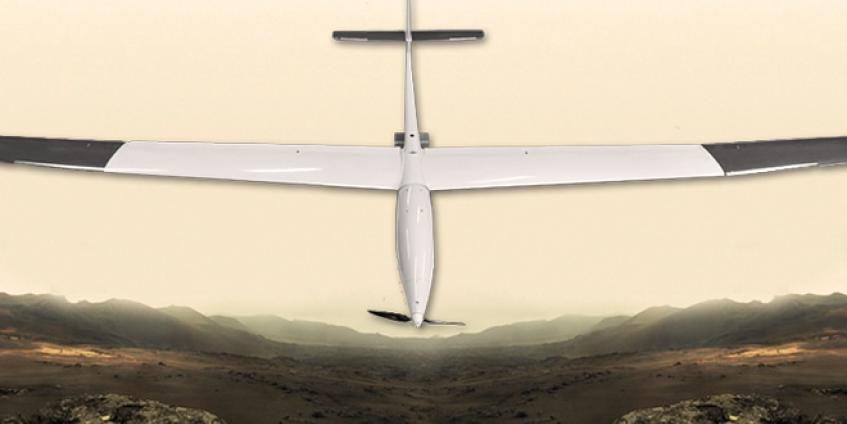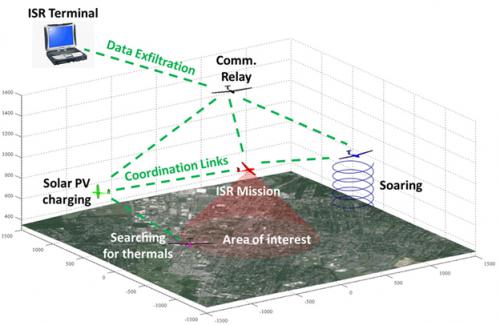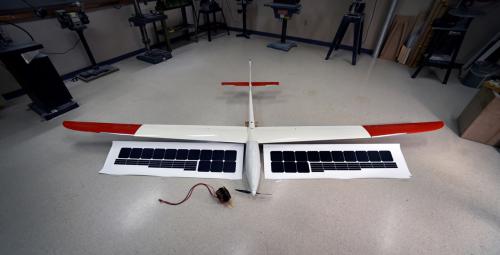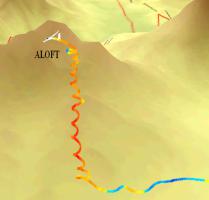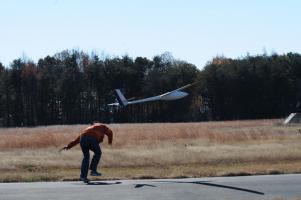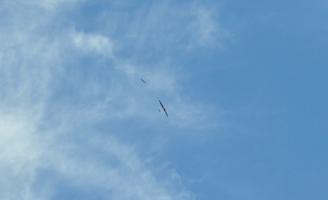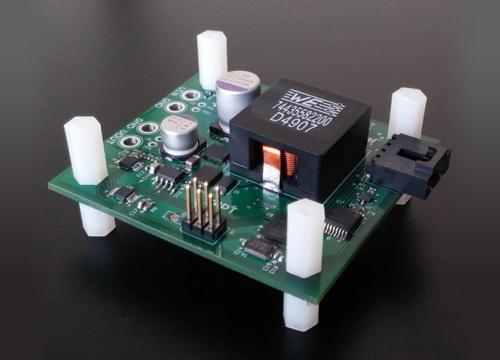INTRODUCTION
The Naval Research Laboratory (NRL), Pennsylvania State University (PSU), and Naval Postgraduate School (NPS), in conjunction with the Marine Corps Expeditionary Energy Office (E2O), are working to demonstrate the innovative energy-harvesting approach (illustrated in Figure 1) for providing persistent intelligence, surveillance, and reconnaissance (ISR) and communications relay capabilities in the form of an unmanned aerial vehicle (UAV). By integrating the latest technologies in photovoltaics, autonomous soaring, high-energy density storage, maximum power point tracking (MPPT), and cooperative flight, the project team plans to deliver a long-sought-after capability of persistent ISR, which operates purely on solar energy. Initial modeling estimates suggest that a 19- to 20-hr endurance threshold for a single aircraft is within reach. Factoring in the collaborative nature of the system and the remaining trade space for optimization of the aircraft and other systems, the Marine Corps may likely be on its way to having a next-generation persistent ISR capability on a platform that requires no operating fuel.
Figure 1: Marine Corps Energy-Harvesting Approach for Persistent ISR.
If all goes as planned, this project could fulfill capability shortfalls specified in various requirements documents for multiple Department of Defense (DoD) Services. This technology is anticipated to have application in a wide range of military unmanned vehicles, dismounted power applications, and installations; and it should be affordable for a wide range of civil and commercial sectors, such as law enforcement agencies, search and rescue organizations, natural resource management agencies, the agriculture community, and possibly even the outdoor recreational and hobbyist communities.
Some may find it surprising that the Marine Corps E2O is interested in funding and endorsing a persistent ISR project; however, energy and power intersect all aspects of the Marine Corps warfighting functions. Therefore, this effort makes a lot of sense when considering the aggregate energy and power needs of deployed troops. In this instance, energy is the driving factor on the persistence side of the equation. When evaluating the Service-level gaps, the overlap between the energy and ISR gaps become even more apparent.
To mitigate development risk, this effort is divided into three phases:
- Phase I: Develop, integrate, and demonstrate key technologies to enable low-altitude, multi-day UAV missions. The key technologies include:
- High Efficiency Photovoltaics.
- Autonomous Soaring Algorithms.
- Energy-Aware Swarming Algorithms.
- Power Management.
- MPPT.
- Phase II: Design and prototype an optimized airframe that enables greater payloads.
- Phase III: Develop multi-day, open-ocean, thermal soaring capability and integrate hydrogen fuel cell technology.
While the plan is to execute the project in multiple phases, the focus of this article is on Phase I.
HIGH-EFFICIENCY PHOTOVOLTAICS
The primary goal of Phase I is to validate the concept of a persistent ISR platform that can operate for extended periods of time with no fuel as well as to deliver a proof-of-concept system. In Phase I, NRL is collaborating with industry partners Semprius and SunPower on the photovoltaics. Semprius is developing novel solar cell technologies that consist of stacked multi-junction (MJ) solar cells. This technology hybridizes two individual triple-junction (3J) solar cells by mechanically stacking them with a transfer-printing method commercialized by Semprius. Independent optimization of the two 3J cells allows each to be fully optimized. The transfer printing allows the MJ cells to be integrated into a single device in a cost-effective, efficient, and commercially established process. Figure 2 indicates the anticipated efficiency values in comparison with current world-record values and the status of the NRL/Semprius technology. During Phase I, NRL is performing the modeling and design optimization and will also manufacture the solar cells. Semprius is forming the stacked MJ devices to prove the concept of the high-efficiency stacked solar cell.
Figure 2: Potential Solar Cell Efficiencies Achievable With the Proposed NRL Technology Compared With Current State-of-the-Art Solar Cells (NRL Graphic).
Because it may be a few years before the stacked MJ cells technology is available, in the interim, NRL has developed Si-based solar arrays in collaboration with SunPower, a leading terrestrial solar array manufacturer, and GaAs-based arrays with MicroLink. The Si-based solar cells can provide a 24% efficiency at the cell level, and NRL has produced arrays configured for incorporation onto UAV wings with a 22% efficiency. While the Si-based technology offers a lower maximum efficiency when compared with GaAs-based technologies (30% to 40% efficiency), the cost of the Si-based
arrays are approximately an order of magnitude less than the cost of GaAs-based technologies. Figure 3 pictures an example of a commercial-off-the-shelf (COTS) glider with custom high-efficiency photovoltaic arrays ready for integration. Within this effort, NRL will build UAV wings with integrated photovoltaics using both the Si-based and GaAs-based solar array wings for a direct comparison of the performance-vs.-cost capabilities of the two technologies.
Figure 3: COTS Glider With Monocrystalline Silicon Photovoltaic Cells (NRL Photo).
THERMAL ALGORITHM
NRL is also refining the Autonomous Locator of Thermals (ALOFT) algorithm. ALOFT was developed by NRL’s Dan Edwards, who designed the algorithm (partly based on NASA’s Cloudswift) to exploit naturally occurring convective thermal updrafts for extending the endurance of UAVs. The ALOFT algorithm essentially uses sensor inputs that detect areas of rising air and then commands an autopilot to orbit within them, resulting in the aircraft gaining altitude [1]. Multiple flights of more than 5 hrs and up to 70 miles have been demonstrated on an unmanned sailplane after a winch launch to just 300 ft of altitude. Figures 4 and 5 show the ALOFT gaining altitude from a thermal updraft and the aircraft used for testing the algorithms.
Figure 4 (top): Flight Data Illustrating ALOFT Gaining 1,500 ft of Altitude in a Thermal Updraft. The Warmer Colors Indicate Higher Climb Rates.
Figure 5 (bottom): Hand-Launching a Powered Sailplane UAV to Test the Autonomous Soaring Algorithms (NRL Photo).
COOPERATIVE SOARING ALGORITHM
Further, PSU and NPS are refining cooperative soaring algorithms. PSU is refining AutoSOAR, a cooperative autonomous soaring algorithm that enables building an energy map of multiple soaring aircraft measurements. This map is used to provide likely energy sources for trajectory optimization between known hotspots, which increases the probability that an aircraft can balance its energy extraction and mission output. NPS is developing a separate cooperative algorithm that focuses on the guidance using a mapped set of likely updraft locations, and it is providing high-fidelity modeling and simulation in daylight conditions. Ultimately, the outcome of NRL, PSU, and NPS efforts will integrate into one. Figures 6 and 7 show flight testing of the cooperative soaring algorithms.
Figure 6 (top): Both NRL and PSU Aircraft Climb in the Same Updraft During Cooperative Autonomous Soaring Testing in 2015 (NRL Photo).
Figure 7 (bottom): NRL and the Air Vehicle Intelligence and Autonomy (AVIA) Lab at PSU Demonstrate Autonomous Soaring Algorithms (PSU Photo).
POWER MANAGEMENT
Persistent ISR with no fuel is a formidable goal that will require expertise in state-of-the-art power management. Power management in electronics is difficult in itself, but power management in a flight application is exceptionally difficult because of the dynamic nature of flight constantly changes solar exposure to different parts of the photovoltaic arrays, by cloud cover, atmospheric conditions, and soaring maneuvers. Such conditions present challenges for characterizing performance and energy management, and, consequently, software control to trigger the appropriate sleep or hibernation states for energy-consuming components.
Fortunately, Packet Digital, another industry partner, is established in dynamic power management. According to NRL, Packet Digital’s approach will address limitations of software-based power management and will provide high-efficiency power distribution with internal load management, resulting in “just in time/just enough” system-wide power management [2]. The Packet Digital Power Manager is pictured in Figure 8.
Figure 8: Power Manager (Packet Digital Photo).
Past Marine Corps efforts with Packet Digital have proven beneficial. For example, a Small Business Innovation Research (SBIR) effort demonstrated that Packet Digital’s unique technology reduced power consumption in commercial radios by more than 40%. Similar technology and expertise will be leveraged to provide a key element of the persistent ISR UAV effort.
MPPT
As mentioned previously, power tracking via an MPPT is vital piece of the persistent ISR equation. As an aircraft maneuvers, an entire array of photocells can be rendered useless if obscured by a shadow. In addition to this problem, photovoltaic cells have a unique current-voltage operating point that produces maximum power. Solar cells generally do not operate at their maximum power point when under a load. This fact is generally true for modules and arrays as well. Thus, the MPPT enables photovoltaic devices to operate at their MPP by decoupling the photovoltaic from the load and computing an algorithm to track the MPP [3]. To address these problems, Packet Digital is leveraging its novel methods for achieving MPPT of a solar array, and it is investigating a new approach to MPPT algorithms that will be more efficient when solar intensities vary across photovoltaic cells. Figure 9 pictures the Packet Digital MPPT assembly.
Figure 9: MPPT Device (Packet Digital Photo).
CONCLUSION
Many researchers tend to charge toward the pursuit of pushing theoretical boundaries for single technologies that improve current capabilities when relatively simple integration of disparate technologies may offer a better approach for capabilities improvement. While some of the technologies described herein are pushing current technological limits, this effort could still produce a capability that advances current capabilities by simply integrating several COTS solutions. This UAV effort has the potential to provide persistent ISR and communications relay capabilities, which closes many of the technology and capability gaps for the military Services. And if all goes according to plan, we expect this phase of the effort to wrap up in late 2016.
References:
- Edwards, D. “Autonomous Locator of Thermals (ALOFT) Autonomous Soaring Algorithm.” Naval Research Laboratory, NRL/FR/5712-15-10,272, 3 April 2015.
- Walters, R. Personal Communication. Naval Research Laboratory, 22 July 2014.
- O’Connor, Maj. Joseph E. “Harvesting Maximum Power From Photovoltaic Solar Cells.” Doctoral Research Proposal, April 2015.


